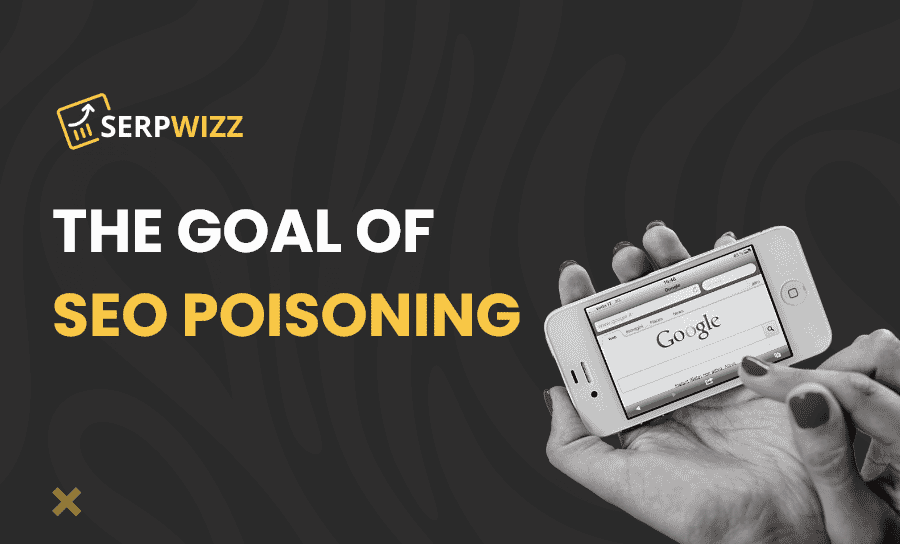
What is the most common goal of search engine optimization (SEO) poisoning?

Have you ever come across a page that was irrelevant to the term searched in the search engine?
Everyone has experienced this at some point in their life. What you may not have known is that SEO poisoning could be the driving factor behind this manipulation.
Therefore, it’s imperative that we understand why SEO poisoning is used and what we need to look for when we suspect that SEO poisoning is at play.
But first, what is SEO poisoning?
To put it simply, SEO poisoning is when a fake web page is created that is then found when users search for a related keyword on a search engine. The end goal of SEO poisoning is to get that web page ranked higher on Google. The impact that this has on the user can be significant. Once this is applied, users will be redirected to an unwanted page.
These pages are usually infected with malware which can be harmful to most desktops. However, from the user’s perspective, we need to know what pages SEO poisoning can impact.
They can impact a variety of pages from a range of topics, but here are some that you need to be aware of:
- Trending topics
- Advertisements
- Holidays
- News items
- Viral videos
These are just a handful of some of the themes that SEO poisoning can impact.
The goals of SEO poisoning
Every SEO service has a goal, and usually, this goal is to rank higher on Google. WIth SEO poisoning, the goals can be a little more specific than that. Here are some of the goals from SEO poisoning:
- Malware distribution
- Information theft
These are the two most important goals from SEO poisoning. The first one is malware distribution. This is when hackers spread malware via email. When we talk about malware, we also mention trojan, which is another form of malware.
When a user approaches or is first approached to this malware, the malware is usually disguised as legitimate software. This can convince the user that they are about to use or install legitimate software.
Malicious users will try and target visitors. This is when users might come across advertisements. This approach means that they can reach a wide audience.
The next goal is information theft. This is when a fake website will ask the user to provide them with valuable information.
An example of this could be that a fake website is anti-virus software, and they get you to give them your contact and payment information before they offer you the service.
How SEO poisoning works
A term that you may be familiar with is blackhat SEO. When people describe SEO poisoning, they often refer to blackhat SEO because the way blackhat SEO works are almost identical when we think about the terms and conditions.
SEO poisoning is tricking the search engine, such as Google, getting fake websites ranked higher on search engines. Google has strict guidelines, and Google knows when they are being broken and can actively send a warning to website owners who break those terms.
Online businesses may use traditional SEO tools to get ranked. These tools could be MOZ or SEMrush. Blackhat SEO can be done without specifically needing to use these tools.
SEO poisoning usually breaks Google’s terms. But what are these terms? They are the following:
- Buying links
- Article marketing
- Link exchanges
- Copied content
The team behind SEO poisoning will avoid paying for advertisements and will go against any traditional way of gaining traffic.
What users need to know
As we have discussed, the negative impacts on the user can be harmful, and therefore it’s best to know the signs of SEO poisoning before clicking on the link or the software. As a user, these are the three areas that you need to look into.
- Up to date browser
- Install antivirus software
- Updating security software
I wanted to include this section because many top experts recommend that users and their businesses stay as alerted and prepared as possible.
To wrap up
We have discussed quite a bit about the context of SEO poisoning, but this information is important when we understand the common goals of SEO poisoning. The best response to the main theme of this article is information theft.
Whether it’s using black hat SEO or distributing malware, information theft always plays a role in SEO poisoning. Both black hat SEO and distributing malware can include traits of information theft. Therefore, we must conclude that stealing user’s information or mimicking previously established forms of information are the most common goals associated with this service.
Above all else, for all online businesses who want to avoid SEO poisoning, be sure to go over the 3 points we discussed in the above section to ensure greater security.
FAQS
The common goal of seo poisoning is when specific keywords are injected into the site that will allow them to show in specific google searches. These websites have bad intentions and are trying to lure users with SEO.
What is the most common goal of search engine optimization poisoning?
The common goal of seo poisoning is to input keywords into a website to help them rank for searches that might not relate to their intentions. SEO poisoning examples can be when a site is hosting a scam for real estate houses but uses keywords like free or cheap to get people to their site and the site is a scam.
About The Author

Sam Edwards
Sam Edwards is a content writer at Serpwizz. He recently wrote an article on the advantages of an SEO audit. He graduated with a degree in Film Studies in 2019 and loves writing film reviews. For more on Sam, please visit his LinkedIn profile. , where you will be able to read some more awesome articles!




